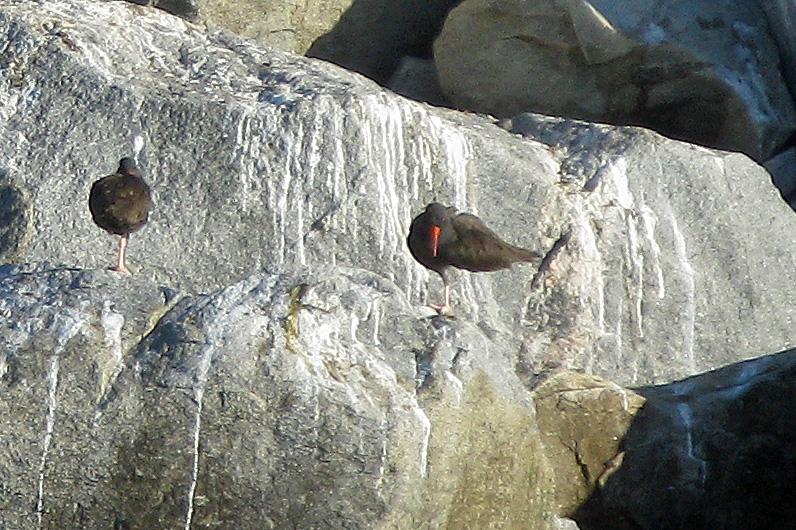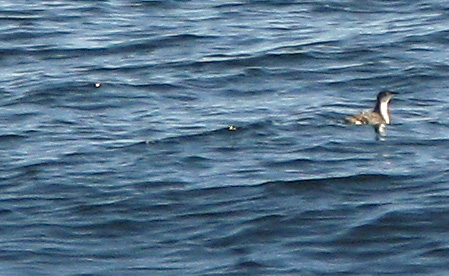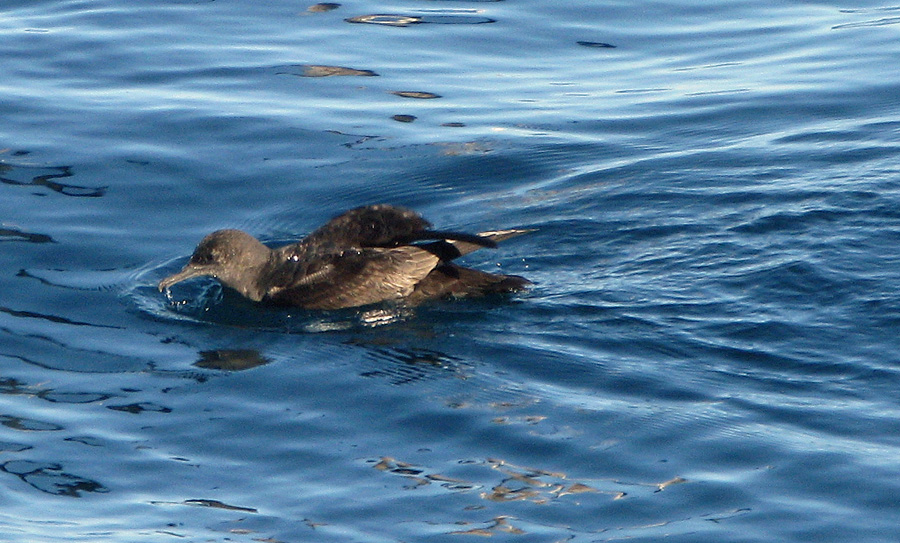#456-#459 Out of Dana Point
Saturday, January 10, I got up bright and early to catch the Ocean Institute’s Sea Explorer out of Dana Point that the Sea & Sage Audubon Society had chartered for a six-hour cruise starting at 8:00 A.M. The goal was just to see what we could find in Orange County Waters. January is a good month for pelagic birding in Orange County waters. Black-vented Shearwater is a lock, and lots of others are possible. According to the trip announcement, we might find “Rhinoceros Auklet, Xantus’ Murrelet, Cassin’s Auklet, Ancient Murrelet, Common Murre, Black-vented Shearwater, Pink-footed Shearwater, Sooty Shearwater, Northern Fulmar”. In fact, we got all but three of those. Weather wise alol you really hyave to worry about is fog, and it sure beats the hell out of January off Long Island.
The route was out a triangle. Steam from Dana Point about 14 miles out to the Sea Knoll, then north and inland to a point five miles out from Fashion Island where the sewer outflow pipe spews, then back to Dana Point.
Before we even got on the boat, the parking lot produced Rock Pigeon, American Crow, Red-tailed Hawk, Brewer’s Blackbird, House Finch, Allen’s Hummingbird, and Rock Pigeon. Before we left the harbor we had Double-crested Cormorant, Hermann’s Gull, Brown Pelican, Snowy Egret, Great Egret, Western Gull, and Ring-billed Gull. On the ocean side of the jetty we found four Black Oystercatchers and some peeps we never did identify. (Sanderlings? Western Sandpipers?)

(Yes, I know the photos are even worse than usual. You try taking pictures of fast moving birds far away from a rocking boat with a point-and-shoot camera.)
At first we mostly just saw more gulls and pelicans, but once we got a little ways offshore we picked up our first real pelagic bird: a Black-vented Shearwater, and my first life bird. Or it would have been if I hadn’t missed it completely. However a few minutes later three more flew by, and these I did get on. We would see many more throughout the day, and got much better looks at them.
Shortly after I finally spotted the shearwaters, three loons flew by, but too far away from a conclusive ID. These were the only loons we saw all day.
Just before 9:00 A.M., the chumming with popcorn starts to pull in a bunch of California Gulls. They will follow the boat for the entire 40+ mile round trip. I can’t swear any individuals actually make the full circuit, but if any drop out, two more take their place.
At 9:02 we spot a darker Shearwater. Yep, it’s a Sooty Shearwater, common off the East Coast but unusual out here.
At 9:05 a Glaucous-winged Gull buzzes the boat. We pick up several of these throughout the day. At the same time a Pomarine Jaeger flies around the back of the boat, but I’m at the front and miss it.
At 9:15 I’m at the back of the boat searching for a Glaucous-winged Gull, when our three Cassin’s Auklets fly by the front of the boat so I miss them. This is not my day. I move back to the front of the boat.
At 9:18, another (or the same?) Pomarine Jaeger flies by, and I see it. OK, things are picking up. Almost immediately after, six Bonaparte’s Gulls fly by. They are not attracted by our chumming, but they do seem to like sewage (the rawer the better) and consequently we spot several hundred of these before the trip is done.
At 9:21, we spot two Common Murres. Despite the name they are not very common, and these are the only ones we see all day.
At 9:25 we spot another Black-vented Shearwater, and then three Cassin’s Auklets. This time I see them: #457. They remind me a bit of Dovekies: little Nerf footballs with very fast flapping wings. Black on top with a white belly. They also remind me of a fat White-throated Swift.
At 9:28 while checking out a Brown Pelican, our leader Jerry Tolman spots another Pomarine Jaeger harassing a gull.
At 9:42, a Cassin’s Auklet lands right by the boat. It’s rare to see them this close, and this is our best look all day.
At 9:52, we stop to check out some gulls and a black spot hanging out on and around a patch of floating kelp. The gulls are just the usual (Western and California) while the Black spot is just a Brandt’s Cormorant. However, at this point in a different direction in the ocean, we spot two very rare Xantus Murrelets! #458. There are only about 8000 of these in the entire world, and many of them breed right here on Santa Barbara island.

I think this is a good example of why pelagic trips should spend more time just sitting and waiting. If we hadn’t stopped to check out the kelp, we never would have seen these two small birds. I’m convinced pelagic trips miss a lot of birds by simply not spending enough time in any one place. Anyway, after the Murrelets fly off toward shore, we continue on out to sea.
At 10:15 another dark Shearwater comes in close to the boat. Another Sooty? No! It’s a Short-tailed Shearwater! #459. Not as rare globally as the Xantus Murrelets, but very unusual in these waters. It hangs around for several minutes letting us get great looks and photographs so we can document this unusual bird.

That tuned out to be my last life bird for the day, though we did continue to see more Shearwaters and Auklets throughout the morning and early afternoon, including one more Sooty Shearwater at noon. We also had a false alert on a possible Phalarope, that turned out to be a literal “trash bird”. (Paper cups bobbing in the ocean can look surprisingly like phalaropes at a distance.)
We also saw several marine mammals including Common and Bottlenose Dolphins. No whales though. Some of the dolphins rode along with our boat for a while. They can surf the bow wake and keep pace with the boat while expending almost no energy:

A little closer to shore we found the usual California Sealions hauled up onto various buoys.
We came back into the harbor about 2:00 P.M, after running a couple of man overboard drills for lost hats. Final bird of the day is a lone Yellow-rumped Warbler I spot in one of the Eucalyptus trees along the shore. Total definite species count was 22 + Loon sp.:
- Sooty Shearwater
- Short-tailed Shearwater
- Black-vented Shearwater
- Brown Pelican
- Bonaparte’s Gull
- Heermann’s Gull
- Western Gull
- California Gull
- Glaucous-winged Gull
- Pomarine Jaeger
- Common Murre
- Xantus’s Murrelet
- Cassin’s Auklet
- Rhinoceros Auklet
- Brown Pelican
- Brandt’s Cormorant
- Double-crested Cormorant
- Great Blue Heron
- Great Egret
- Snowy Egret
- Black-crowned Night-Heron
- Red-tailed Hawk
- Black Oystercatcher
- Ring-billed Gull
- Rock Pigeon
- American Crow
- California Towhee
- Brewer’s Blackbird
- House Finch
